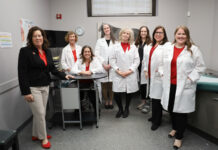A team that included UofL cardiologists Michael Flaherty and Naresh Solankhi, and UofL cardiothoracic surgeon Matthew Williams, performed the first transcatheter aortic-valve replacement (TAVR) procedure on a 47-year-old male patient Dec. 21, 2011.
During the procedure they inserted a biological valve through a catheter and implanted it within a diseased aortic valve. The procedure allows for valve replacement without traditional open-heart surgery and while the heart is beating, therefore avoiding cardiopulmonary bypass.
It is the only valve replacement option for patients with severe aortic stenosis who are not well enough to undergo traditional open-heart surgery, Flaherty said. Most patients will avoid any surgery in their chest.
“For patients who qualify, the TAVR procedure is often their last hope for treatment of their heart disease,” said Flaherty, who is assistant professor of medicine, physiology and biophysics and director of research-interventional cardiology in UofL’s Department of Medicine. “It’s a unique procedure, and we are once again proud to be on the cutting edge of heart care in the region.”
During the TAVR procedure, a cardiologist and cardiothoracic surgeon work together to implant the new heart valve, called the Edwards SAPIEN valve, which is made from cow tissue and developed by Edwards Lifesciences Corp.
The valve is inserted into the body through a small cut in the leg. Once delivered to the site of the patient’s diseased valve, the Edwards SAPIEN valve is expanded with a balloon and immediately functions in place of the patient’s valve.
Jewish Hospital is one of 29 sites in the United States where researchers are studying the Edwards SAPIEN transcatheter aortic heart valve and the next-generation Edwards SAPIEN XT valve as part of an ongoing national clinical trial called the PARTNER II Trial. The Edwards SAPIEN valve – studied in the first PARTNER Trial and used in Europe since 2007 – recently received FDA approval for the treatment of inoperable patients in the United States. This is the first U.S. commercial approval for a transcatheter device enabling aortic valve replacement without the need for open-heart surgery.
“The availability of the TAVR procedure marks a major milestone in the treatment of valve-related heart disease,” said Williams, who practices with University Cardiothoracic Surgical Associates and is assistant professor of thoracic and cardiovascular surgery in the Department of Surgery at UofL. “It gives us another tool to help take care of people. Older folks, who would prefer to avoid surgery if they can, will be the patients who will most often benefit.”




























